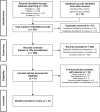Interventions promoting occupational balance in adults: A systematic literature review
- PMID: 40472017
- PMCID: PMC12176295
- DOI: 10.1371/journal.pone.0325061
Interventions promoting occupational balance in adults: A systematic literature review
Abstract
Introduction: Occupational balance, the subjective perception of satisfaction and balance in engaging in meaningful activities, is fundamental to individuals' health and well-being. The detrimental impacts of decreased occupational balance are increasingly acknowledged, and interventions are emerging. A comprehensive review of these interventions, targeting occupational balance in adult populations, is needed to ensure effective implementation into both clinical and public health settings.
Objective: This study aimed to systematically review and synthesize existing interventions that address occupational balance among adults in diverse contexts, and to evaluate their effectiveness.
Method: A systematic literature search was conducted in PubMed, CINAHL, the Cochrane Library, and EMBASE in April 2024, following the PRISMA guidelines. Peer-reviewed articles published between 2000 and 2024, reporting quantitatively on interventions addressing occupational balance, were included. The NHLBI quality assessment tools were employed to evaluate the risk of bias. A narrative synthesis was performed.
Results: Of the 347 records identified, 18 publications were included in this review. Study designs comprised randomized controlled trials, observational studies, and pre-post studies. Most participants had specific diagnoses, with a predominance of mental health conditions. The review identified 12 interventions aimed at promoting occupational balance, providing an overview of interventions' target groups, goals, features, and content. Overall effectiveness of identified interventions varied across studies, with six demonstrating statistically significant improvements in occupational balance scores. Clinically meaningful changes were observed in areas such as drug craving, social isolation, and work ability.
Conclusion: This review identified promising interventions for promoting occupational balance and enhancing health, well-being, and life satisfaction across various settings. Further research should employ controlled experimental designs to evaluate interventions addressing occupational balance across diverse populations, addressing gender and age differences while assessing effectiveness across delivery modes and settings.
Copyright: © 2025 Lentner et al. This is an open access article distributed under the terms of the Creative Commons Attribution License, which permits unrestricted use, distribution, and reproduction in any medium, provided the original author and source are credited.
Conflict of interest statement
The authors have declared that no competing interests exist.
Figures
References
-
- Lewis S, Gambles R, Rapoport R. The constraints of a ‘work–life balance’ approach: an international perspective. Int J Human Res Manag. 2007;18(3):360–73. doi: 10.1080/09585190601165577 - DOI
-
- Biggs S, McGann M, Bowman D, Kimberley H. Work, health and the commodification of life’s time: reframing work–life balance and the promise of a long life. Age Soc. 2016;37(7):1458–83. doi: 10.1017/s0144686x16000404 - DOI
Publication types
MeSH terms
LinkOut - more resources
Full Text Sources
Miscellaneous


